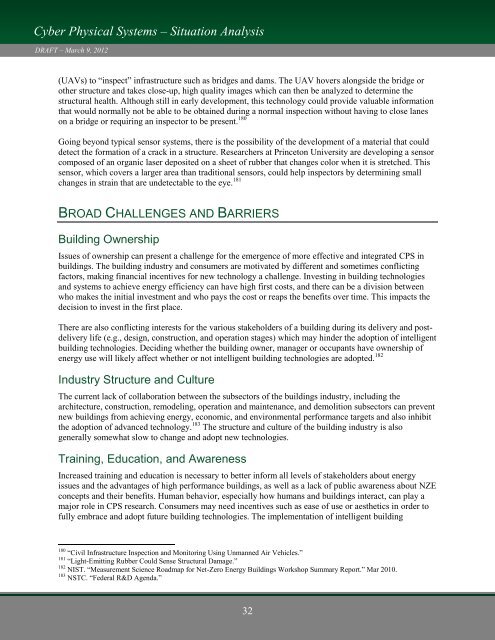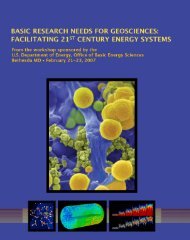<strong>Cyber</strong> <strong>Physical</strong> <strong>Systems</strong> – <strong>Situation</strong> <strong>Analysis</strong>DRAFT – March 9, 2012222,000 square foot commercial building that was designed to be ultra efficient and achieve NZE statususing photovoltaics. Design of the RSF required a ―whole building‖ integrated process, as well asconsiderations of every aspect of office environment and energy use. There are many examples oftechnologies that are used in the RSF where cyber and physical components are tightly integrated–energyuse is continuously studied and adjusted, automatic windows can be electronically lightened or darkenedto control sunlight and heat flow, and carbon dioxide sensors respond to occupancy and controlventilation when needed. Even various factors of human behavior were taken into consideration in orderto decrease the amount of energy used per worker and create a redesigned office space. 176Smart Sensors and Structural Health MonitoringSmart sensors are examples of technology that exists today and will expand and become even smarter inthe future to play an essential role in CPS. Structural health monitoring (SHM) is an emerging field incivil engineering which allows the possibility of continuous or periodic assessment of the condition ofcivil infrastructure. Current sensors can discretely monitor factors such as strains, accelerations,deformations, and corrosion potential. 177 SHM could provide the information to assess the condition ofbridges, buildings, dams or other structures and help to determine when preventative maintenance isnecessary, thus preventing structural failure or costs. Smart sensors, which are typically low cost andbattery powered, and have an on-board microprocessor and sensing capability, are a viable option for thesensors to be used in SHM projects.The European research project Wireless Sensor and Actuator Networks for Critical InfrastructureProtection (WSAN4CIP) has recently successfully demonstrated cost-effective wireless sensor systemsfor monitoring of electricity distribution and water networks. These types of systems are designed tosecure and better manage different types of critical infrastructure. In the test case for a power distributionnetwork, examples of what the secure wireless sensor system can provide include information about andlocations of disruptions of power, as well as automatic filming of locations if an intruder is detected. Inthe drinking water network test case, the system was shown to provide data about water pressure to helpindicate if there is a disruption, as well as detection of intruders via open door contacts. 178There are numerous bridges which have implemented structural health monitoring systems using sensornetworks. One example of a wireless SHM system that is currently being implemented is on the JindoBridge in South Korea, a joint project between the University of Illinois at Urbana-Champaign, theUniversity of Tokyo, and the Korean Advanced Institute of Science and Technology. Original sensorswere installed in 2009 and more were added in 2010, resulting in a system of sensors along the bridge thatmeasures a total of 659 channels of data. These sensors prove data about various physical states of thebridge and will email the research team if anomalies are detected. The wireless smart sensor nodes areeven self-powered by sunlight and wind; the network monitors the battery levels of the sensors. Althoughthe sensor system on the Jindo Bridge is not the first of its kind, it is much cheaper to deploy than systemsthat have been established on other bridges. This system of wireless sensors runs costs around $100 persensing channel compared to others such as the $15,000 per sensor system installed on the Bill EmersonMemorial Bridge in Missouri. 179In addition to sensor systems, there are other areas of emerging technology involving cyber-physicalsystems in civil infrastructure. One emerging idea is the possibility of using unmanned air vehicles176 http://www.nytimes.com/2011/02/15/science/15building.htm, http://www.nrel.gov/sustainable_nrel/rsf.html177 French, C. et al. ―Report on the NSF Bridge Workshop.‖178 http://www.wsan4cip.eu/news/view/article/wireless-sensors-for-infrastructure-protection.html179 ―Wireless Monitoring of Civil Infrastructure Comes of Age.‖31
<strong>Cyber</strong> <strong>Physical</strong> <strong>Systems</strong> – <strong>Situation</strong> <strong>Analysis</strong>DRAFT – March 9, 2012(UAVs) to ―inspect‖ infrastructure such as bridges and dams. The UAV hovers alongside the bridge orother structure and takes close-up, high quality images which can then be analyzed to determine thestructural health. Although still in early development, this technology could provide valuable informationthat would normally not be able to be obtained during a normal inspection without having to close laneson a bridge or requiring an inspector to be present. 180Going beyond typical sensor systems, there is the possibility of the development of a material that coulddetect the formation of a crack in a structure. Researchers at Princeton University are developing a sensorcomposed of an organic laser deposited on a sheet of rubber that changes color when it is stretched. Thissensor, which covers a larger area than traditional sensors, could help inspectors by determining smallchanges in strain that are undetectable to the eye. 181BROAD CHALLENGES AND BARRIERSBuilding OwnershipIssues of ownership can present a challenge for the emergence of more effective and integrated CPS inbuildings. The building industry and consumers are motivated by different and sometimes conflictingfactors, making financial incentives for new technology a challenge. Investing in building technologiesand systems to achieve energy efficiency can have high first costs, and there can be a division betweenwho makes the initial investment and who pays the cost or reaps the benefits over time. This impacts thedecision to invest in the first place.There are also conflicting interests for the various stakeholders of a building during its delivery and postdeliverylife (e.g., design, construction, and operation stages) which may hinder the adoption of intelligentbuilding technologies. Deciding whether the building owner, manager or occupants have ownership ofenergy use will likely affect whether or not intelligent building technologies are adopted. 182Industry Structure and CultureThe current lack of collaboration between the subsectors of the buildings industry, including thearchitecture, construction, remodeling, operation and maintenance, and demolition subsectors can preventnew buildings from achieving energy, economic, and environmental performance targets and also inhibitthe adoption of advanced technology. 183 The structure and culture of the building industry is alsogenerally somewhat slow to change and adopt new technologies.Training, Education, and AwarenessIncreased training and education is necessary to better inform all levels of stakeholders about energyissues and the advantages of high performance buildings, as well as a lack of public awareness about NZEconcepts and their benefits. Human behavior, especially how humans and buildings interact, can play amajor role in CPS research. Consumers may need incentives such as ease of use or aesthetics in order tofully embrace and adopt future building technologies. The implementation of intelligent building180 ―Civil Infrastructure Inspection and Monitoring Using Unmanned Air Vehicles.‖181 ―Light-Emitting Rubber Could Sense Structural Damage.‖182 NIST. ―Measurement Science Roadmap for Net-Zero Energy Buildings Workshop Summary Report.‖ Mar 2010.183 NSTC. ―Federal R&D Agenda.‖32
















